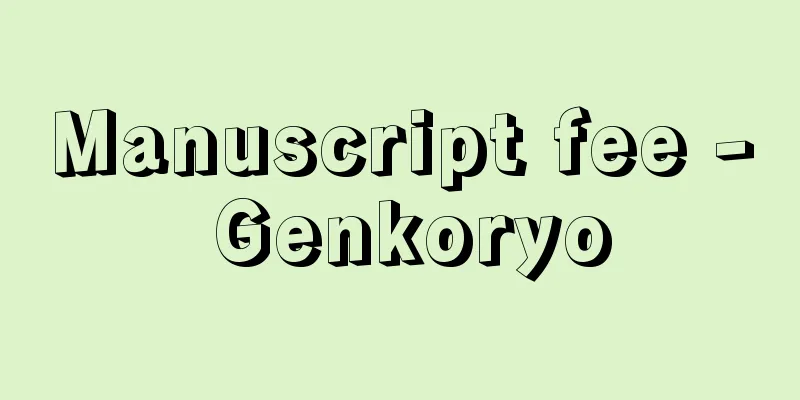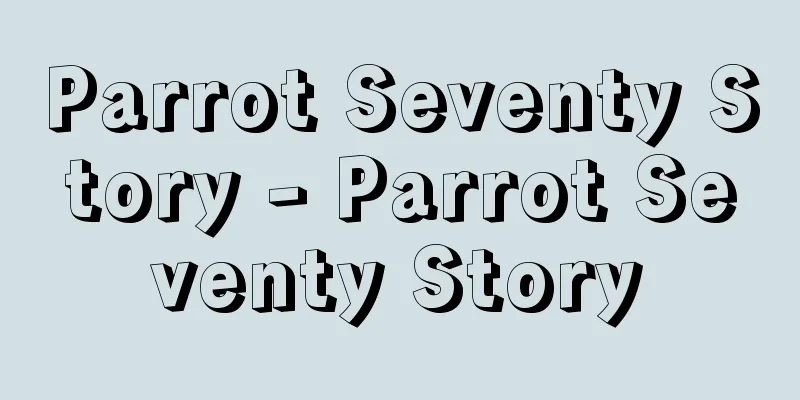Manuscript fee - Genkoryo

|
A copyright fee paid for manuscripts published or used in books, magazines, newspapers, broadcasts, etc. It differs from royalties in that a fixed amount is paid in full one time. The price is usually set per 400-character manuscript sheet, but can also be set per full length column, poem, or other work. In the West, it is often calculated by the number of words. Payment is usually made between the time of manuscript delivery and one or two months after publication. The standard price varies depending on the circumstances of the publisher, the nature of the publication medium, and the status and fame of the author, and is not fixed. It is said that the first person to receive something resembling a manuscript fee in Japan was Santokyoden, a sharebon (comic book) writer from the Edo period. The current manuscript fee system was established in the Taisho period, when copyright became a professional issue and modern management of newspapers and publishing companies was established. According to the Income Tax Act, income tax is withheld from manuscript fees, and companies deduct this from the amount paid to the author and pay it to the tax office. In addition to writing, fees for translation, composition, and publishing of interviews are also subtypes of manuscript fees. [Hitoshi Suzuki and Norio Tamura] "Study of manuscript fees - Economics of writers and journalists" edited by Matsuura Sozo (1978, Japan Journalist Academy Publishing Division) [Reference] | |Source: Shogakukan Encyclopedia Nipponica About Encyclopedia Nipponica Information | Legend |
|
書籍、雑誌、新聞、放送などに掲載もしくは使用された原稿に対して支払われる著作権使用料としての報酬。一定額を1回限りで全額支払う点で印税と異なる。通常400字詰め原稿用紙1枚を単位として価格を定めるが、コラム、詩など著作物の全編を単位とすることもある。欧米では語数計算される場合が多い。支払いは、原稿受渡し時から発行後1~2か月以内が普通。価格の基準は、発行元の事情、発表媒体の性格、著作者の地位・有名度などにより異なり、一定しない。日本で最初に原稿料らしきものをもらったのは、江戸時代の洒落本(しゃれぼん)作家山東京伝(さんとうきょうでん)であるといわれる。現今の原稿料方式が定着したのは、著作権の職業的自覚と、新聞社、出版社の近代的経営が成立した大正時代に入ってからである。所得税法によって、原稿料から源泉所得税が徴収されることになっており、企業が、著作者に支払う額から差し引いて税務署に納める。 著作以外に、翻訳料、作曲料、談話掲載料なども原稿料の亜種である。 [鈴木 均・田村紀雄] 『松浦総三編著『原稿料の研究――作家・ジャーナリストの経済学』(1978・日本ジャーナリスト専門学院出版部)』 [参照項目] | |出典 小学館 日本大百科全書(ニッポニカ)日本大百科全書(ニッポニカ)について 情報 | 凡例 |
>>: Manuscript paper - Genkouyoushi
Recommend
confrerie (English spelling)
...Strikes against employers were often launched,...
Ethyl vanillin
Vanilla essence is used as a flavoring agent. Sour...
epiphysis
The pineal gland is an endocrine gland that protr...
Pseudo-asymmetric carbon atom
…The central carbon atom of the trihydroxyglutari...
Miyake Shosai
A Confucian scholar in the mid-Edo period. His gi...
Chain car - Chain wheel
⇒ Sprocket Chain wheel Source: About Shogakukan Di...
The world's concubine form - Sekentekakekatagi
Ukiyo-zoshi. Temperamental Subjects. Four volumes....
orbiwlaris
...Distributed in Honshu. There are variations de...
Suspended business - business suspension
〘 noun 〙 An administrative measure to suspend the ...
Macrosociology
...In the past, the term education was limited to...
Adsorption potential
...Also, for adsorbents with many micropores, the...
Completely artificial heart
...Also, in the sense of temporarily taking over ...
Bunkyo Hifuron - Bunkyo Hifuron
A book on poetics written by Kukai. It was comple...
Battle of Ormedo - Battle of Ormedo
… Juan II, who was a man of great political and d...
European pipe - European pipe
Eustachian tube (Modern Terminology Dictionary (19...









